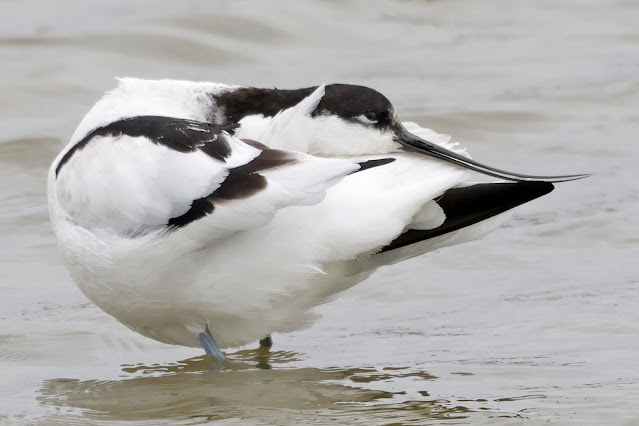My initial plan today was to go to Southsea to hopefully catch up with the Red-necked Grebe that has been around for the last few days. However just before leaving there was a report that there was no sign, so I changed plans and headed for the Bridge Street car park once more. This time I just intended to check the floods and not walk the canal path and would then go onto the Haven, or where ever should anything else be reported.
On arrival there was a report of Sand Martin, so I headed down the path scanning the skies as I went. On reaching the footpath that runs along the bottom of Posbrook Floods I picked up some hirundines over the trees. I could see Sand Martin, and what I thought was a House Martin. I started to photograph what I thought were the Sand Martin, but it turns out that it was in fact the House Martin.
Scanning the floods I could see Black-tailed Godwits and a pair of Pintail, then at the back two Glossy Ibis.
The fox walked ahead of me and after it went around a bend, it came back to check if I was still coming. I caught up with it as it stopped to inspect a leaf and have a good scratch.
Once again there were plenty of singing Chiffchaff in the adjacent willow trees.
Opening the window in the hide it was good to see that more of the reeds had been cut back to show a lot more of the north scrape. With the water levels high the normal island the snipe roost on was virtually covered. around half a dozen had taken up roosting amongst the cut reeds.
There were more Mediterranean gulls here on the scrapes with most of them occupying the central causeway.
A recent feature around the reserve has been the young male Goosander. It was first seen as a red head, in eclipse plumage last summer and has now turned into a smart male Goosander. However he has struck up a relationship with a female Shelduck. It is not clear what the thinking is here, does the Goosander think he is a Shelduck as there are so many, or maybe he thinks the female Shelduck is a Goosander.
Breeding would be difficult I am sure as the two ducks have different diets for one thing. What is clear though is that the Goosander is never far from his Shelduck mate.
Despite all the drama around the relationship it is good to get some great views of a very smart duck.
As well as the Snipe there was a single Lapwing feeding amongst the cut reeds.
Avocet numbers have gradually built up over the last few weeks with a high count today of 42. They are now almost all in pairs and feed together all over the scrapes. This individual though spent sometime preening close to the hide and put in some lovely positions to show off the black and white plumage and that magnificent bill.
Back to the Goosander and things were hotting up, as well as following the female Shelduck around the Goosander was clearly not prepared to lose her to one of own kind. If any male Shelduck came too close then this is what would happen.
The continental form is Motacilla alba alba –
White Wagtail – and it breeds commonly across Europe, from as far west as
Iceland (and even Greenland) east to the Ural Mountains and Turkey, reaching as
far north as the Arctic Circle. Many are migratory, spending the winter in
southern Europe and Africa, and as far south as Kenya and Malawi.
White Wagtail is a passage migrant through Britain from
early March to May and from mid-August to early November. Most we receive are
from the Faroe Islands, Greenland and Iceland – indeed, it's likely that
the entire populations of these birds pass through Britain and Ireland.
An adult White Wagtail is a fetching bird, especially males. Perhaps the most striking feature is the mantle – clean and silvery-grey, contrasting markedly with the head and wings. This smart appearance is rather different to the dark, smoky and diffuse tones of Pied Wagtail. The rump is pale grey on White Wagtail – black on Pied.
So at last some movement and the first hirundines of the year. There was more action on the scrapes than I expected s all in all a good day

























































No comments:
Post a Comment